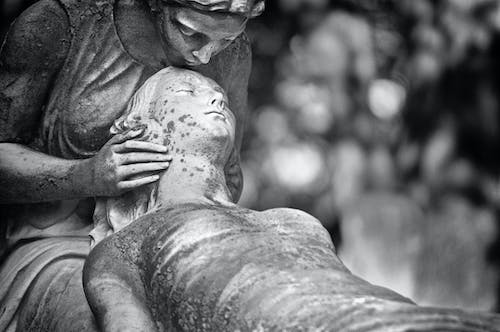Death is the great equalizer; it’s a subject that intrigues and terrifies us in equal measure. Throughout human history, we’ve pondered what lies beyond the threshold of life, seeking answers in religion, philosophy, and science. Yet, despite all our advancements, the mystery of death remains largely intact. However, modern medicine and science have provided us with invaluable insights into the physiological processes that occur when life ebbs away. In this article, we’ll delve into what happens to our bodies when we die, as explained by medical professionals.
1. The Journey Begins: The First Signs of Dying
When death approaches, the body starts signaling its decline through various physiological changes. Vital signs such as blood pressure and heart rate may fluctuate, signaling the beginning of the end. This stage is often marked by a decrease in responsiveness and consciousness. Dr. Emily Brooks, a palliative care physician, explains that during this time, the body prioritizes its basic functions, such as maintaining blood flow to essential organs like the brain and heart.
2. The Final Breath: Understanding the Mechanics of Death
As the body’s systems begin to shut down, breathing patterns alter. Agonal breathing, often referred to as “death rattle,” occurs as a result of reduced brain function. Dr. Michael Greene, an emergency room physician, describes it as irregular, gasping breaths caused by the brain’s inability to regulate breathing properly. While this can be distressing for loved ones to witness, it’s a natural part of the dying process and typically painless for the individual.
3. A Slumbering Brain: The Role of Neurotransmitters
The brain, the seat of consciousness and identity, undergoes significant changes as death approaches. Neurotransmitter activity diminishes, leading to a state of profound unconsciousness. Dr. Sarah Chang, a neurologist, explains that as oxygen levels decrease, brain cells become deprived of vital nutrients, leading to widespread neuronal death. This process ultimately results in the cessation of brain function, a defining characteristic of death in medical terms.
4. The Heart’s Final Beat: Understanding Cardiac Arrest
Cardiac arrest, the cessation of heart function, is often cited as the moment of death. Dr. James Rodriguez, a cardiologist, elucidates the physiological mechanisms behind this critical event. As the heart’s electrical impulses falter, its ability to pump blood effectively diminishes, depriving the body of oxygen and nutrients. Without prompt intervention, irreversible damage occurs, culminating in the cessation of cardiac activity.
5. The Body’s Last Hurrah: Understanding Rigor Mortis
Following death, the body undergoes a series of postmortem changes collectively known as rigor mortis. Dr. Amanda Chen, a forensic pathologist, explains that this process occurs due to the depletion of ATP, the body’s primary energy source. Without ATP, muscle fibers become locked in a contracted state, leading to stiffness in the body’s joints and limbs. While the onset and duration of rigor mortis vary, it serves as a reliable indicator of the time since death in forensic investigations.
6. A Symphony of Decay: Decomposition and Putrefaction
Once the heart ceases to beat and oxygen is no longer delivered to tissues, the body begins to undergo decomposition. Dr. Benjamin Hayes, a forensic anthropologist, describes this process as a complex interplay of microbial activity, enzymatic breakdown, and environmental factors. Initially, autolysis, the self-digestion of cells, sets in, followed by the proliferation of bacteria and fungi. As decomposition progresses, the body undergoes a series of characteristic changes, from bloating to skeletalization, each stage offering valuable insights into the postmortem interval.
7. Beyond the Physical: Exploring the Mystery of Consciousness
While science can elucidate the physiological processes of death, the question of consciousness remains a tantalizing enigma. Dr. Sophia Patel, a psychiatrist specializing in end-of-life care, reflects on the existential and metaphysical aspects of dying. She emphasizes the importance of holistic approaches to death, acknowledging the profound emotional and spiritual dimensions that transcend mere physicality. While science may provide glimpses into the mechanics of death, it is our humanity that imbues the experience with meaning and significance.
8. The Aftermath: Coping with Grief and Loss
Death isn’t just a biological phenomenon; it’s a deeply emotional and existential experience for those left behind. Dr. Jonathan Kim, a psychologist specializing in grief counseling, discusses the complex process of mourning and bereavement. He emphasizes the importance of support networks, rituals, and healthy coping mechanisms in navigating the tumultuous terrain of grief. While the loss of a loved one may leave an indelible void, it also serves as a poignant reminder of the preciousness of life and the interconnectedness of humanity.
Death remains one of life’s greatest mysteries, a threshold we all must eventually cross. Through the lens of modern medicine and science, we’ve gained unprecedented insights into the physiological processes that accompany dying. From the slowing of vital signs to the onset of rigor mortis, each stage offers a glimpse into the intricate dance of life and death. Yet, beyond the realm of biology, death transcends mere physicality, touching the very essence of our humanity. As we confront our mortality, may we find solace in the richness of our shared human experience and the enduring legacy of those who have gone before us.
Read More: Alkaline water: a healthy way of hydrating or over-hyped nonsense?
